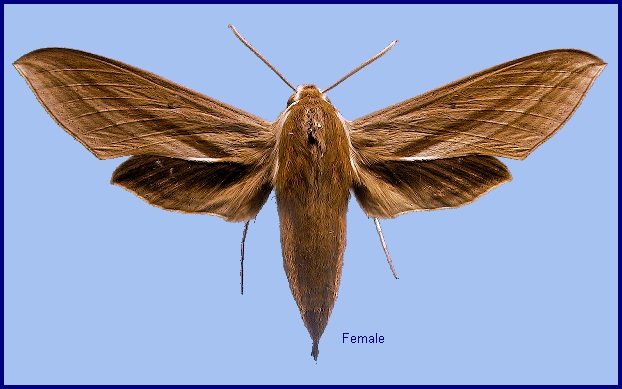
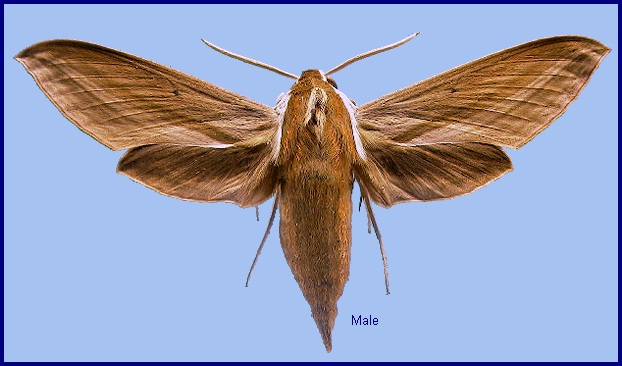
Choerocampa japonica Boisduval, 1869, in Orza, Lépid. japon. Expos.: 36. Type locality: Japan.
Synonym. Choerocampa japonica Boisduval, 1869.
Synonym. Deilephila suifuna Staudinger, 1892.
Synonym. Theretra japonica alticola Mell, 1939.
[Further details on this species in Japan, as well as photos of many stages, can be found on Digital Moths of Japan as well as Moths of the southern Shikoku, Japan.]
Wingspan: 55--80mm. Forewing upperside with first and second postmedian lines fused; pale, parallel-sided band present between second and fifth postmedian lines but only slightly paler than the ground colour. Hindwing upperside with indistinct beige median band. Abdomen upperside with two obscure dorsal longitudinal lines.
In the male genitalia, uncus very slender, rounded apically, upperside convex but not subcarinate. Gnathos broad, parallel-sided, apex truncate with rounded angles. Harpe short, broad, hollowed distally, ridges bordering cavity notched. Phallus with narrow, band-like armature; proximal edge of left lobe dentate, right process short, dentate.
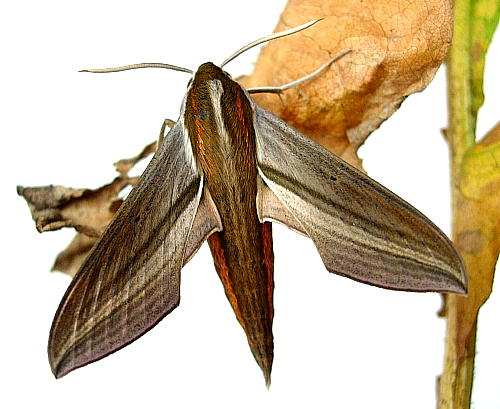
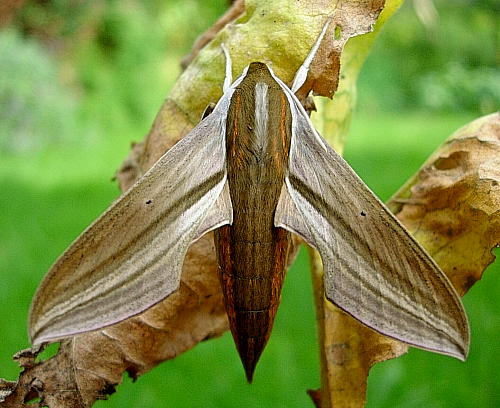
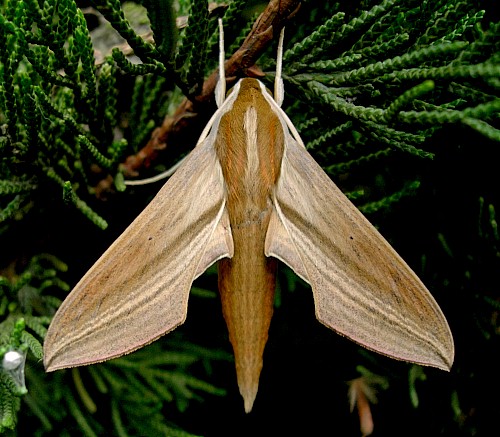
In the Russian Far East a species of woodland areas characterized by Quercus mongolica. Active between 22.50h and 02.40h (females), and 23.40h until 04.30h (males) (Izerskiy, 1999b).
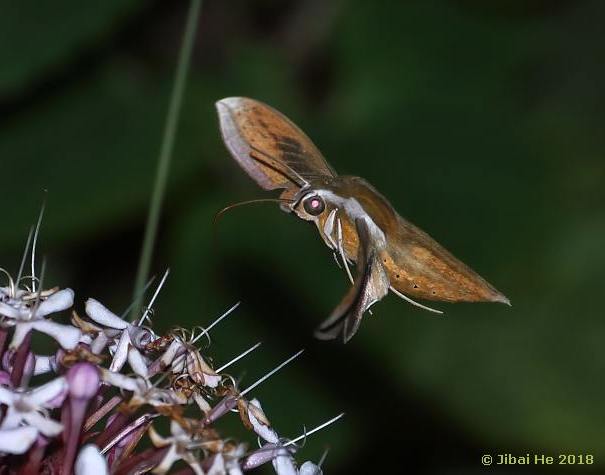
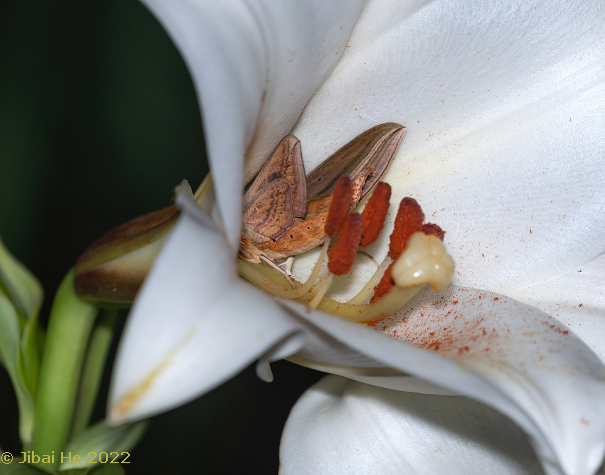
China: iv (Guangdong; Zhejiang); v (Jiangsu); vi (Nei Mongol; Hubei; Beijing); vii (Nei Mongol; Jiangsu; Shandong; Sichuan; Zhejiang); 20.vii (Shaanxi); 31.vii (Zhejiang); viii (Hubei; Fujian); 3-13.viii (Zhejiang); 20-25.viii (Zhejiang); 31.viii (Sichuan, 2800m); ix (Shandong; Shaanxi; Beijing; Sichuan); 30.ix (Zhejiang). South Korea: vii (Inchon); 9 vii [(unstated locality)]. Japan: 9.v (Shikoku); 21.v-29.viii (Honshu); 22.vi (Ryukyu Archipelago); 2.vii-4.viii (Hokkaido); ix (Hokkaido); 16.x (Ryukyu Archipelago). Russia: 18.vi-15.vii (Khabarovskiy Krai); 12.vii-12.ix (Primorskiy Krai).
There are between one and four generations a year in China, with one or two normal for Beijing and four for Jiangxi (Chu et al., 1979).
Park et al. (1999) give mid May until early September as the flight period in Korea.
OVUM: Oval (1.25 x 1.52mm), pale green, slightly oval and shiny. Laid singly on both the upper and underside of the hostsplant leaves, but with often many to a plant. During damp, wet weather, many perish due to fungal infections.
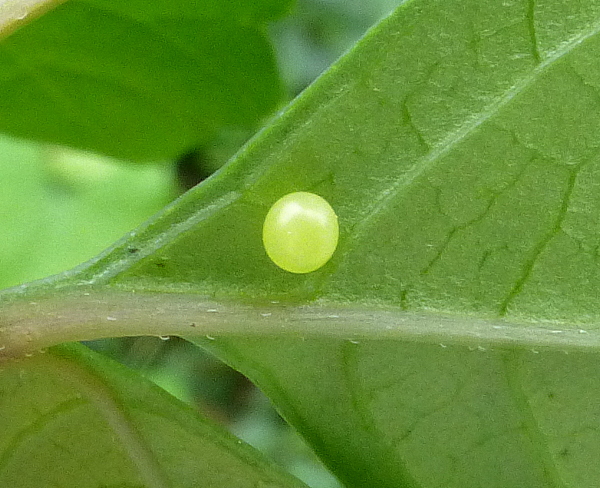
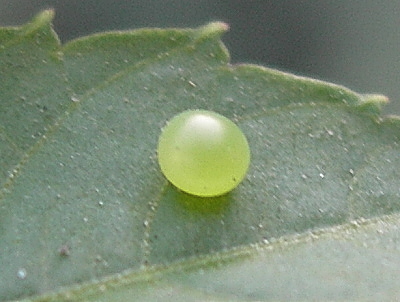
LARVA: Full-fed 75--80mm.
Full-grown larvae were common on Parthenocissus tricuspidata growing over walls in Beijing on 8.vii.1995 (Pittaway & Kitching, 2000). This species is also very fond of mats of Causonis japonica [syn. Cayratia japonica] growing over shrubs in full sun (Pittaway, pers. obs. 2007).
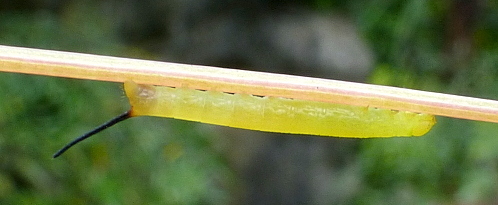
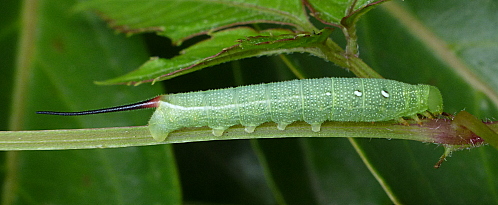
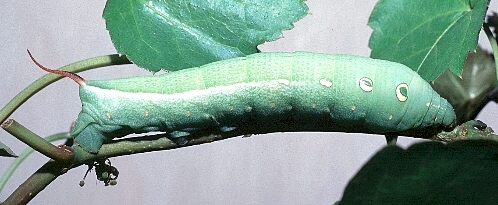
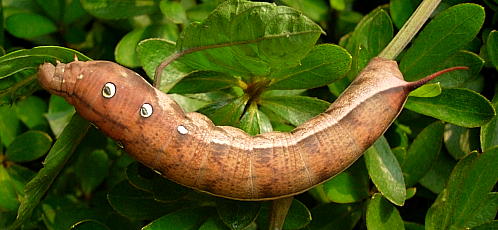
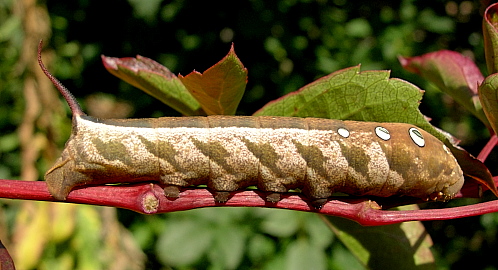
PUPA: 42--48mm. Colour sandy-brown, sometimes darker; sides of tongue-sheath, head, legs and wings dotted with black; wing-case with clearly marked pale veins edged narrowly greyish. There is a very narrow brownish-green dorsal stripe from 2 to 13 and an obscure broad dorso-lateral stripe. The whole pupa is densely marked with short, dark streaks; the spiracles are black set in a black surround; the cremaster dark brown.
Less elongate and cylindrical than T. silhetensis. The tongue-case not projecting much frontad. Antenna slightly shorter than fore leg, which reaches to one-third the distance to the tip of wing-case, mid-leg to two-thirds that distance. There is a long, narrow coxal piece. Surface dull. Edge of tongue-case not shiny but mesially channelled. Head, thorax and sides of tongue-case coarsely but superficially wrinkled. Wing-case with surface minutely wrinkled. Segment 3 with some pits behind the spiracle of 2; abdomen very finely transversely wrinkled and shallowly pitted; hind bevels of 8 to 10 smooth, front bevels of 9 to 11 minutely pitted. Spiracle of 2 a narrow slit lying between the slightly raised, shallowly emarginate hind margin of 2 and a narrow, transverse, oblong lobe, its front edge raised, hind edge depressed, projecting from the front margin of 3; remaining spiracles oval, the surface rising gently to the central slit, which has a narrow, shiny rim. Cremaster cone-shaped, sharply pointed, shiny tip seen under a lens to be minutely bifid; ventral surface keeled, with a channel on each side of the keel.
An active species, which moves at the slightest disturbance. Formed in a loose cocoon among leaves and debris on the ground.
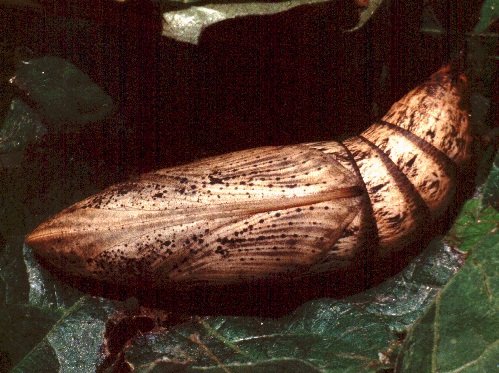


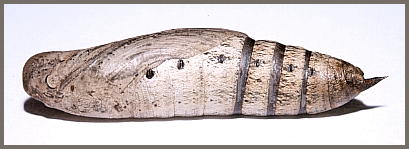
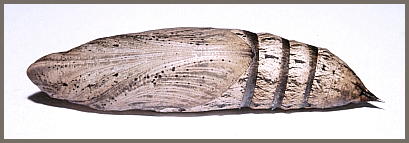
Larval hostplants. Recorded in China on Cissus, Colocasia, Hydrangea, Parthenocissus, Ampelopsis, Ipomoea batatas, Causonis japonica [syn. Cayratia japonica] and Vitis (Mell, 1922b; Yang, 1978; Chu et al., 1979; Chu & Wang, 1980). A record on Saxifraga stolonifera (Chu et al., 1979) requires confirmation, while another, on Hedera nepalensis var. sinensis (Yang, 1978), is probably erroneous.
In August 2004 numerous eggs and larvae were found on Ludwigia along a lake at Hangzhou, Zhejiang (Pittaway, pers. obs. 2004). These same plants were also being utilized by Theretra silhetensis. Elsewhere around Hangzhou, and Shanghai and Beijing, the main host was Causonis japonica [syn. Cayratia japonica].
In Metro-Manila, the Philippines, larvae have also been found on various species of Cayratia (Dvořák, 2014).
![Flowering mat of Causonis japonica [syn. Cayratia japonica], West Lake, Hangzhou, Zhejiang, China. Photo: © Tony Pittaway. Flowering mat of Causonis japonica [syn. Cayratia japonica], West Lake, Hangzhou, Zhejiang, China. Photo: © Tony Pittaway.](cay_jap2.jpg)
![Causonis japonica [syn. Cayratia japonica], West Lake, Hangzhou, Zhejiang, China. Photo: © Tony Pittaway. Causonis japonica [syn. Cayratia japonica], West Lake, Hangzhou, Zhejiang, China. Photo: © Tony Pittaway.](cay_jap.jpg)
Recorded in Korea on Colocasia antiquorum, Oenothera erythrosepala, Circaea mollis and Hydrangea paniculata (Park et al., 1999).
Recorded in Japan from Hydrangea paniculata (Nozakai & Miyata, 1989), as well as Ampelopsis brevipedunculata, Causonis japonica [syn. Cayratia japonica], Circaea, Fuchsia, Oenothera biennis, Oenothera stricta, Parthenocissus tricuspidata and Vitis (Inoue et al., 1982; Sugi, 1987).
Recorded in the Russian Far East from Vitis amurensis (Izerskiy, 1999b).
(Easily reared in captivity on various species of Epilobium, even Epilobium hirsutum, but best started on smoother-leaved species.)
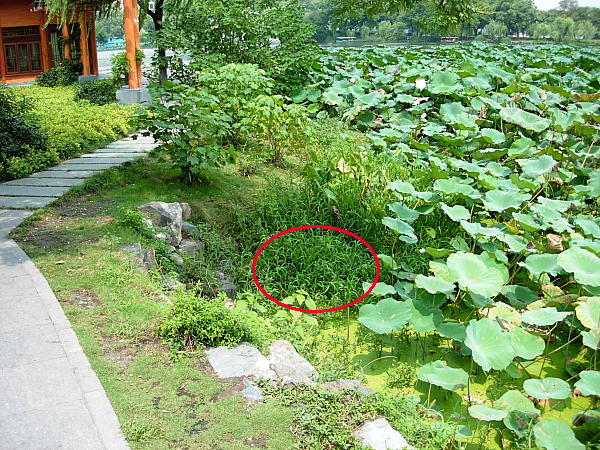
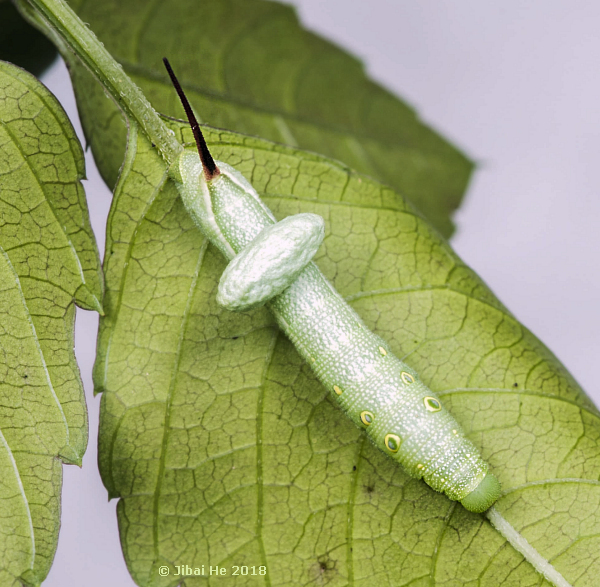
China: Nei Mongol (Zalantun/Butha Qi; Chifeng/Ulanhad, Daguangdingzishan, 2061m); Heilongjiang; Liaoning (Huanren; Dalian); Hebei; Beijing (Beijing City; Baihua Shan; Badaling National Forest Park; Haidian); Shandong (Qingdao; Weihai; Yantai); Shanxi (Taiyuan; Xiaxian); Shaanxi (Louguantai Forest Park; Xi'an; Xunyang, 1380m); Qinghai (Nangqian County); Henan; Jiangsu (Nanjing; Yangkou); Anhui (Mt. Huang Shan; Huainan); Shanghai; Zhejiang (Tianmu Shan; Hangzhou; Jiushan Island); Hubei (Changyang; Wuhan; ??Lui Shin Tze); Sichuan (Batang; Chengdu; Kangding); Chongqing (Chongqing); Yunnan (Ya'an); Guizhou (Jiangkou; Leishan; Shiqian); Hunan (Shangzhi, 1440m); Jiangxi (Le'an); Fujian (Guangze, 1200m); Guangdong (Guangzhou; Jiufeng, east of Nan Ling).
Taiwan: Matsu Island.
North Korea: South Pyongan Province (Pyongyang).
South Korea: Baengnyeong-do & Daecheong-do; Seoul; Kyonggi Province; Kangwon Province; North Chungchong Province; South Chungchong Province; North Cholla Province; South Cholla Province; North Kyongsang Province; South Kyongsang Province; Cheju Province
Japan: Hokkaido; Honshu (Mt. Hanna; Taira; Tokyo; Yokohama; Mikaboyama, 750m; Kugenuma; Mt. Gozaisho; Fujimi Heights; Kisojihara; Ohdaru Spa; Kiyosato; Oki Islands (Kadowaki & Kishida, 1977); Asagiri-kogen (Kishida et al., 2018)); Shikoku (Usa); Kyushu (Takakumayama); Tsushima (Sasuna); Tanegashima; Ryukyu Archipelago (Amamio-shima; Okinawa (Manabe et al., 2014; Miyano, 2015); Ishigaki-jima; Yaku-shima).
Russia: Amurskaya (Blagoveshchensk); Khabarovskiy Krai (Slavyanka; Bolshekhekhtsyrskii Nature Reserve, Khabarovsk suburbs; Pivan; Kiselevka); Primorskiy Krai (Andreevka; Tigrovoy; Suifen River; Jankowski Peninsula; Promorskiy; Novovladimirovka; Khasan; Ussuriysk; Vityaz Bay; Kedrovaya Pad Nature Reserve; near Kalinovka; near Zanadvorovka; Anisimovka).
Occurs from the Korean Peninsula and Primorskiy Krai, Russia, south through eastern and central China to Sichuan, Guizhou, Hunan and Guangdong; also in Taiwan and Japan.
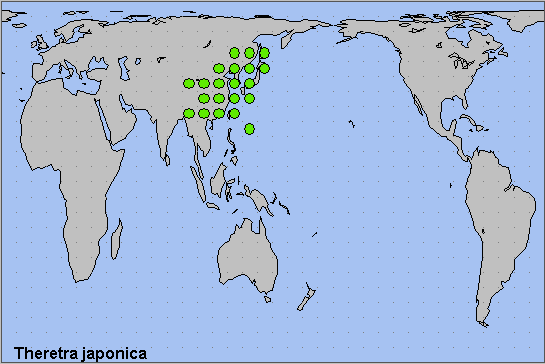
Holarctic; eastern Palaearctic region.
 Return to Sphingidae of the Eastern Palaearctic species list
Return to Sphingidae of the Eastern Palaearctic species list